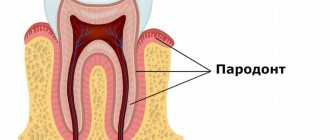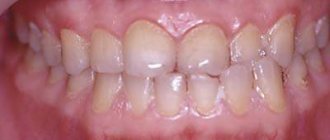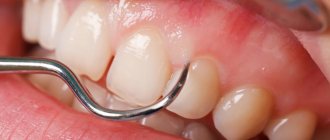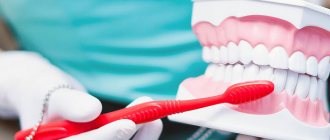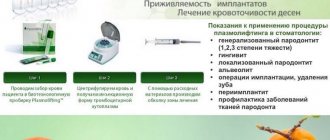Prevention
- Primary: prevention of dental diseases by eliminating the causes and conditions of their occurrence, as well as increasing the body’s resistance to adverse factors.
- Secondary: a set of measures aimed at preventing relapses and complications of diseases.
- Tertiary: a system of measures aimed at the rehabilitation of dental status by preserving the functionality of organs and tissues of the maxillofacial area, mainly by replacement.
Preventive measures are beneficial to everyone without exception. They are especially needed by patients suffering from endocrine diseases, pregnant women, and people with bad habits.
Types of periodontitis
Depending on the extent of inflammation of the periodontal tissue, periodontitis can be:
- focal - pathology is concentrated on one or several adjacent teeth;
- generalized – characterized by damage to all or most teeth. This type of periodontitis is included in the list of the most complex and unresolved problems in the field of dental services.
According to the nature of the course, acute, chronic and aggravated periodontitis is distinguished.
Spicy
This type of periodontitis occurs mainly in a focal form. The disease can begin suddenly with damage to 1-3 adjacent teeth.
Chronic
In the chronic form of the pathology, progressive cyclic gum damage is observed. They periodically bleed or make themselves felt by a feeling of itching. Chronic periodontitis is accompanied by increased mobility and displacement of teeth.
Aggravated
The symptoms are similar to acute periodontitis. According to statistics, it is the most frequently diagnosed type of periodontal inflammation in children aged 4-13 years.
Primary prevention of periodontal disease involves
- training in the basics of individual oral hygiene, monitoring the quality of its implementation;
- carrying out professional hygienic treatment of the oral cavity at certain intervals;
- elimination of violations of the architectonics of the soft tissues of the vestibule of the oral cavity, abnormal attachment of cords and frenulum (short cords and frenulum, small vestibule of the oral cavity);
- according to indications - timely orthodontic treatment in order to normalize the distribution of mechanical load on the teeth and at the same time - eliminate the conditions in which the activity of microbial influences increases.
It is primary prevention, its timely initiation and implementation on the required scale that allows us to solve the problem of periodontal diseases. Secondary and tertiary prevention are always strictly individual and depend on the existing consequences of the disease.
Treatment of hyperplastic (hypretrophic) gingivitis
At the first stage, the same set of measures is provided as for catarrhal gingivitis.
If the treatment is ineffective, sclerotherapy is indicated: injections into the gingival papillae of sterile hypertonic solutions (10% calcium chloride or gluconate solution, 40% glucose solution, 90% ethyl alcohol). The administration of 0.1-0.3 ml of such solutions is carried out under local anesthesia. The injection is carried out with a thin needle from the top of the papilla to its base simultaneously in 3-4 papillae. The interval between injections is 1-2 days, the course is 4-8 injections. Pregnant women with this form of gingivitis do not undergo sclerotherapy.
Treatment of ulcerative-necrotizing gingivitis
Includes:
- relief of acute gum inflammation;
- reducing intoxication of the body, increasing the resistance of the body and periodontal tissues;
- elimination of local unfavorable factors that may contribute to the progression of the inflammatory-destructive process.
The treatment plan repeats the sequence of medical actions for other inflammatory periodontal diseases, but there are some features [10, 19, 20]:
- professional hygiene is carried out in stages under local anesthesia (applications, oral baths with lidocaine solution; if necessary, infiltration or conduction anesthesia);
- at the first visit, only supragingival dental deposits are removed;
- other local measures are carried out as the inflammatory process subsides.
It is important that both the doctor when seeing a patient and the patient at home use antiseptics that release atomic oxygen and chlorine-containing solutions, which have an adverse effect on the anaerobic microflora. Acceleration and facilitation of the removal of necrotic tissue from the surface of the gum lesion is ensured with the help of proteolytic enzymes. To optimize the epithelization of tissues (after cleansing them from a film of necrotic tissue), keratoplasty preparations are used.
Systemic (general) therapy for patients with necrotizing ulcerative gingivitis includes (Table No. 1):
- antibacterial drugs (beta-lactam antibiotics - penicillins and cephalosporins), tetracycline antibiotics, macrolides, antiprotozoal drugs (metronidazole);
- anti-inflammatory drugs;
- vitamins, adaptogens;
- hyposensitizing agents.
Criteria for assessing the effectiveness of complex treatment of inflammatory periodontal diseases can be:
- improvement of the patient’s general condition;
- relief of inflammation - in acute gingivitis;
- stabilization of periodontal status - with periodontitis;
- improvement of parameters assessed by additional research methods.
We are far from thinking that we were able to take into account and present all aspects of complex therapy, and especially drug therapy, for inflammatory periodontal diseases, and we admit that some of the materials were not included in this publication. Therefore, all constructive comments from readers will be received with gratitude.
For readers interested in this issue, we provide a list of recommended literature.
LITERATURE
- Abaev Z. M., Domashev D. I., Antidze M. K. et al. Modern methods of treatment and prevention of periodontal diseases // Dentistry. - 2012, No. 4. - P. 72-74.
- Wolf G.F., Rateitzhak E.M., Rateitzhak K. Periodontology; lane with German; edited by G. M. Barera. - M.: MEDpress-inform, 2008. - 548 p.
- Goncharova E.I. Herbal remedies in the prevention and treatment of periodontal diseases // Ros. stoma magazine. - 2012, No. 3. - P. 48-52.
- Grudyanov A.I. Periodontal diseases. — M.: Publishing house “Med. information agency", 2009. - 336 p.
- Grudyanov A.I., Aleksandrovskaya I.Yu. Planning of therapeutic measures for periodontal diseases. — M.: LLC “Med. information agency", 2010. - 56 p.
- Grudyanov A.I., Ovchinnikova V.V., Dmitrieva N.A. Antimicrobial and anti-inflammatory therapy in periodontology. — M.: LLC “Med. information agency", 2004. - 80 p.
- Periodontal diseases. Modern view on clinical, diagnostic and therapeutic aspects: study. village, recom. UMO MH&SR and Ministry of Education. RF / Yanushevich O. O., Grinin V. M., Pochtarenko V. A., Runova G. S. et al.; edited by O. O. Yanushevich. - M.: GEOTAR-Media, 2010. - 160 p.
- Krazhan D.S., Garazha N.N., Orlov M.N., Morgoeva Z.Z. Potentiated effect of antiseptics and sorbents on the microflora of periodontal pockets // Med. Bulletin of the North Caucasus. - 2012, No. 2. - P. 40-42.
- Lobko S. S., Khomenko A. I., Shadurskaya S. K., Petruk A. A. Therapeutic dentistry: Etiotropic therapy of marginal periodontal diseases: Textbook. allowance. - Mn.: BSMU, 2001. - 70 p.
- Makeeva I.M., Kudryavtseva T.V., Erokhin A.I., Akulovich A.V. Periodontal diseases: a guide. to practice therapist classes. dentistry for students IV and V courses of stoma. faculties. - MEDpress-inform, 2009. - 96 p.
- Makeeva I.M., Smirnova T.N., Chernousov A.D. et al. The use of lactoferrin in the complex treatment of dental diseases (literature review) // Dentistry. - 2012, No. 4. - P. 66-71.
- Müller H.-P. Periodontology; lane with him. - Lvov: GalDent, 2004. - 256 p.
- Patient management plans. Dentistry / ed. O. Yu. Atkova, V. M. Kamenskikh, V. R. Bosyakova. - M.: GEOTAR-Media, 2010. - 240 p.
- Platonov I. A., Andreeva T. A. Workshop and methodological guidelines on pharmacology. Part 2. Ed. prof. I. A. Platonova. - Smolensk, 2009. - 106 p.
- Modern aspects of clinical periodontology / Ed. L. A. Dmitrieva. - M.: MEDpress, 2001. - 128 p.
- Therapeutic dentistry: national. manual / ed. L. A. Dmitrieva, Yu. M. Maksimovsky. - M.: GEOTAR-Media, 2009. - 912 p.
- Filatova N.A., Elizova L.A., Chekhova N.O., Kostryukov D.A. Possibilities of achieving stabilization of the inflammatory process in periodontitis // Int. scientific-practical conf. "Achievements and prospects in dentistry." - 1999. - T. 1. - P. 257-260.
- Tsarev V.N., Ushakov R.V. Antimicrobial therapy in dentistry: Guide. — M.: Med. information agency, 2004. - 144 p.
- Tsepov L. M. Periodontal diseases: a look at the problem. - MEDpress-inform, 2006. - 192 p.
- Tsepov L. M., Nikolaev A. I., Mikheeva E. A. Diagnosis, treatment and prevention of periodontal diseases. — 3rd ed., rev. and additional - MEDpress-inform, 2008. - 272 p.
- Tsepov L. M., Nikolaev A. I., Nesterova M. M. et al. System doctor - patient - periodontal pathology: reasons for suboptimal interaction that reduces the quality of dental care // Dental South. - 2012, No. 8. - P. 28-29.
- Yudina N. A., Lyugovskaya A. V., Kurochkina A. Yu. Antimicrobial therapy in the treatment of periodontal diseases: educational method. allowance. - Minsk: BelMAPO, 2008. - 42 p.
Oral hygiene
Individual oral hygiene is the main method of primary prevention of periodontal diseases:
- regular and proper brushing of teeth (3 times a day);
- using high-quality toothbrushes and toothpastes;
- the use of additional means of prevention (flosses, interdental brushes, irrigators, devices for cleaning the tongue, etc.).
Factors in choosing personal hygiene products
- age;
- the presence of dental diseases or a predisposition to them;
- individual characteristics of the oral cavity (atypical structure of the dentition and shape of the teeth, the presence of orthopedic or orthodontic structures in the oral cavity, etc.).
Prevention of hypersensitivity of dental tissues
About 62% of the adult population in Russia suffers from painful tooth sensitivity. Most often, increased sensitivity occurs when the necks of teeth are exposed due to periodontal disease. In addition, it can cause the development of periodontal diseases due to unsatisfactory tooth brushing due to the pain of its implementation. Special toothpastes, rinses, flosses and gels are used as therapeutic and prophylactic agents for increased dental hypersensitivity.
Elimination of local factors
A number of local factors contribute to increased accumulation of dental plaque. There are a number of such factors: cervical carious cavities; unrestored interdental contacts; overhanging edges of fillings; edges of artificial crowns deeply advanced under the gum; foci of demineralization of gingival surfaces; lack of equator of tooth crowns; wide and attached close to the gingival edge of the frenulum and strands of the mucous membrane; availability of orthodontic devices; close arrangement of teeth, etc. Therefore, timely elimination of the listed factors is a necessary component of the prevention of inflammatory periodontal lesions.
Elimination of supercontacts and functional selective grinding
The traumatic factor is one of the most significant. In the absence of physiological abrasion of the enamel tubercles, which is observed in 20-22% of the population, in order to prevent increased and uneven load on the periodontium, functional selective grinding is carried out.
Surgical elimination of deformation of the soft tissues of the oral vestibule
Correction of pulling cords, frenulums, and small vestibule of the oral cavity should be carried out before they have time to lead to destructive lesions. The optimal period is the school period, after the completion of the formation of the alveolar process.
Bite correction
Malocclusion affects the condition of the periodontium, usually due to uneven mechanical load on the periodontium. Therefore, correcting malocclusion in childhood has a significant preventive effect.
Prophylactic use of antiseptic drugs
When carrying out preventive measures, it is necessary to use antimicrobial drugs that affect periodontal pathogenic microflora. Some of the most effective agents are chlorhexidine and triclosan. The use of products containing these substances should be supervised by specialists.
Professional oral hygiene
Professional oral hygiene is an important point in the system of preventing inflammatory periodontal diseases. We use the following tools: scalers, air-abrasive systems (handy blasters), such as Air-Flow (EMS); abrasive polishing pastes.
Causes of childhood periodontitis
The development of childhood periodontitis may be due to the following factors:
- decreased immunity, which makes the oral mucosa more susceptible to waste products of pathogenic bacteria;
- malocclusion;
- diabetes;
- a seal placed in bad faith;
- violation of daily oral hygiene;
- side effects of medications;
- nutritional errors - excessive consumption of sweets, soda, very cold or very hot foods.
Here the uniform is blue
The benefits of our preventative procedures
- special attention to the condition of the oral cavity during pregnancy;
- strengthening gums with the help of professional procedures: therapeutic dressings, applications, coatings.
- individual selection of hygiene products;
- timely detection of the development of gum disease at an early stage, which facilitates the treatment process.
We hope that preventative measures will help you never experience gum disease. However, gum inflammation can occur against the background of certain body conditions:
- stress;
- hormonal changes: puberty, pregnancy, diseases of the internal secretion organs;
- diseases of the endocrine system - high levels of glucose in the blood (diabetes of any type); vascular diseases; gastrointestinal tract;
- problems with the absorption of certain vitamins and microelements;
- the presence of pathogenic microflora in the oral cavity.
In case of suspicion of serious disorders that played a role in the development of gum disease, Kuntsevo specialists give a referral for examination by doctors in other departments. A multidisciplinary approach to each patient allows not only to cope with the symptoms, but also to eliminate the underlying causes.
Kuntsevo dentists guarantee high quality of services provided. We not only relieve our patients of discomfort and relieve inflammation, but also fight the underlying causes that led to the development of the disease, which ensures lasting results and prevention of relapses.
Treatment of periodontitis in children at Profident Junior
Dentists at the Profident Junior clinic with over 10 years of experience and high qualifications know 100% how to treat periodontitis in the youngest patients in Odessa. When selecting therapy, our specialists take into account the individual nature of the problem. Depending on the characteristics of the disease, gum treatment is selected:
- vitamin and antibiotic therapy;
- dressings and compresses with medications;
- cleaning interdental spaces and periodontal pockets from pus;
- laser excision of affected tissue.
For home use, special medicated toothpastes and gels are prescribed that provide anti-inflammatory and preventive effects.
